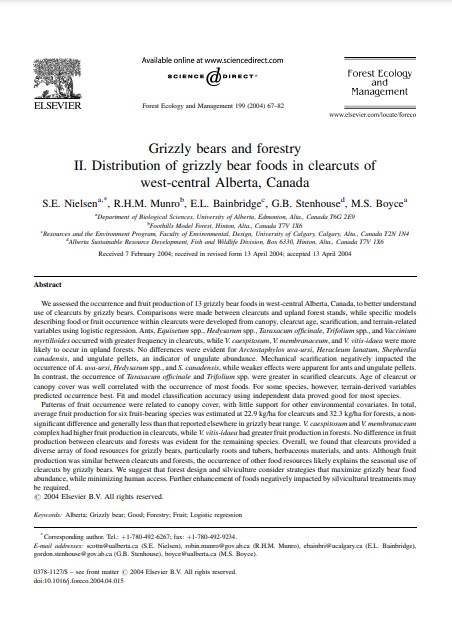Grizzly Bears and Forestry II: Distribution of Grizzly Bear Foods in Clearcuts of West-central Alberta, Canada
Bosque Modelo:
Foothills
Temática:
Conservación
Tipo de documento:
Artículo científico
Resumen
We assessed the occurrence and fruit production of 13 grizzly bear foods in west-central Alberta, Canada, to better understand use of clearcuts by grizzly bears. Comparisons were made between clearcuts and upland forest stands, while specific models describing food or fruit occurrence within clearcuts were developed from canopy, clearcut age, scarification, and terrain-related variables using logistic regression. Ants, Equisetum spp., Hedysarum spp., Taraxacum officinale, Trifolium spp., and Vaccinium myrtilloides occurred with greater frequency in clearcuts, while V. caespitosum, V. membranaceum, and V. vitis-idaea were more likely to occur in upland forests. No differences were evident for Arctostaphylos uva-ursi, Heracleum lanatum, Shepherdia canadensis, and ungulate pellets, an indicator of ungulate abundance. Mechanical scarification negatively impacted the occurrence of A. uva-ursi, Hedysarum spp., and S. canadensis, while weaker effects were apparent for ants and ungulate pellets. In contrast, the occurrence of Taraxacum officinale and Trifolium spp. were greater in scarified clearcuts. Age of clearcut or canopy cover was well correlated with the occurrence of most foods. For some species, however, terrain-derived variables predicted occurrence best. Fit and model classification accuracy using independent data proved good for most species. Patterns of fruit occurrence were related to canopy cover, with little support for other environmental covariates. In total, average fruit production for six fruit-bearing species was estimated at 22.9 kg/ha for clearcuts and 32.3 kg/ha for forests, a nonsignificant difference and generally less than that reported elsewhere in grizzly bear range. V. caespitosum and V. membranaceum complex had higher fruit production in clearcuts, while V. vitis-idaea had greater fruit production in forests. No difference in fruit production between clearcuts and forests was evident for the remaining species. Overall, we found that clearcuts provided a diverse array of food resources for grizzly bears, particularly roots and tubers, herbaceous materials, and ants. Although fruit production was similar between clearcuts and forests, the occurrence of other food resources likely explains the seasonal use of clearcuts by grizzly bears. We suggest that forest design and silviculture consider strategies that maximize grizzly bear food abundance, while minimizing human access. Further enhancement of foods negatively impacted by silvicultural treatments may be required.
Información Bibliográfica
Autor:
Nielsen, SE, RHM Munro, E Bainbridge, MS Boyce and GB Stenhouse.
Revista:
Forest Ecology and Management
Año:
2004
N°:
-
País :
Canadá
Páginas:
67 - 82
Volumen:
199
Idioma:
Ingles
Palabras claves
Alberta; Grizzly bear; Good; Forestry; Fruit; Logistic regression





